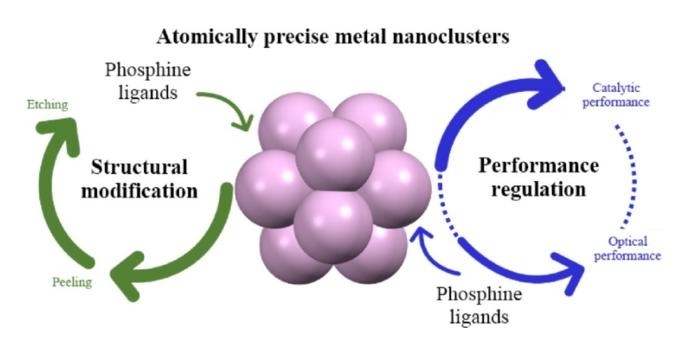A group of scientists examined a novel way of altering the architectures of ultra-small nanomaterials. These metal nanoclusters bridge the gap between the metal atom and the bulk metal, making them extremely helpful in fundamental and practical research. Metal nanoclusters offer the potential for a wide range of biological applications.
 Phosphine ligands modify the structure of metal nanoclusters in a top-down evolutionary process by “peeling” and “etching.” This phosphine-LEIST reaction allows the construction of metal nanoclusters with functional catalytic performance and optical properties. Image Credit: Polyoxometalates, Tsinghua University Press
Phosphine ligands modify the structure of metal nanoclusters in a top-down evolutionary process by “peeling” and “etching.” This phosphine-LEIST reaction allows the construction of metal nanoclusters with functional catalytic performance and optical properties. Image Credit: Polyoxometalates, Tsinghua University Press
The research paper was published in the journal Polyoxometalates.
The researchers looked at the phosphine-LEIST reaction. This approach has advantages in the structural alteration and property manipulation of metal nanoclusters.
The method we reviewed is able to modulate the atomically precise structure of metal nanoclusters and regulate their corresponding performance.
Man-Bo Li, Professor, Anhui University
Metal nanoclusters operate as bridges between nanoparticles and molecules due to their amazing size properties and exact topologies. They offer scientists with a great platform for researching the structure and property modification of nanomaterials at the atomic level.
Scientists working in the field of metal nanocluster chemistry have increasingly focused on the influence of peripheral ligands on metal nanoclusters in recent years. Ligands are atoms or molecules that attach to the metal ion directly.
Researchers have gradually come to understand that the spatial structure and bonding mechanism of organic ligands could have a major effect on the topological and electronic structure, stability, solubility, and associated features of metal nanoclusters. Thus, the field of ligand engineering in metal nanocluster chemistry is becoming indispensable.
Previously, direct synthesis techniques and metal doping were used to synthesize nanoclusters. The ligand-exchange-induced size/structure transformation (LEIST) was developed by scientists as a direct synthesis process. Utilizing the LEIST technique, several nanoclusters have been created. Thanks to LEIST, researchers now have a better knowledge of the transformation process in metal nanoclusters as well as more opportunities for application.
The researchers investigated the structural alterations caused by phosphine ligands, as well as the accompanying catalytic and optical performance regulation of metal nanoclusters. They aimed to find a way to reconcile the stability and activity of metal nanoclusters.
Li added, “The ultimate goal is preparing ultra-stable and highly active metal nanoclusters for practical applications. The most exciting application would be catalysis, because metal nanoclusters possess precise structures, abundant surface activation sites, and recycling capability. They are ideal industrial catalysts, combining the advantages of homogeneous and heterogeneous catalysts.”
Using the LEIST technique for phosphine ligands, scientists have proposed novel possible applications for phosphine-protected metal nanoclusters in recent years. Phosphine ligands can change the structure of metal nanoclusters in a top-down evolutionary process that “peels” and “etches” distinct template nanoclusters. Phosphine ligands can also be synthesized using various ways.
Researchers have found an increasing number of phosphine ligands with various functional characteristics throughout time. These are being used by researchers to alter existing metal nanocluster formations. Phosphine ligands show promise for structural modification of metal nanoclusters.
The work of the team emphasizes the crucial need to generate a broader range of functionalized phosphine ligands.
“As more and more phosphine ligands are designed and synthesized, the applications of metal nanoclusters in various fields will be significantly expanded,” Li noted.
The researchers concentrated on the phosphine-induced structural changes of metal nanoclusters and the resultant performance regulation in their review. The phosphine ligand-induced nanocluster changes were emphasized. They highlighted the numerous accomplishments of structural alteration utilizing the phosphine-LEIST approach.
They also talked about how phosphine-induced structural change can work in tandem with other synthetic approaches. Finally, they discussed the possible function of phosphine ligand engineering in altering the features of metal nanoclusters, such as optical and catalytic activity.
The researchers concluded from their review that the phosphine-induced changes of atomically precise metal nanoclusters offer considerable potential as research subjects and merit additional investigation in producing and using these metal nanoclusters.
Wenwen Fei, Yang Tao, Yao Qiao, Sheng-Yan Tang, and Man-Bo Li from the Institutes of Physical Science and Information Technology, Anhui University, Hefei, China were the study contributors.
This study was supported by the National Natural Science Foundation of China, the Anhui Provincial Natural Science Foundation, and Anhui University's Startup Fund.
Journal Reference:
Fei, W, et. al. (2023) Structural modification and performance regulation of atomically precise metal nanoclusters by phosphine. Polyoxometalates. doi:10.26599/POM.2023.9140043